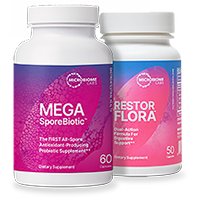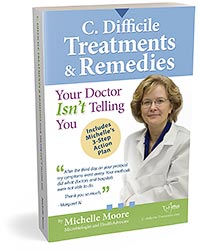We’ve all heard about healthy probiotic bacteria that are added to drinks, yogurt and supplements. The traditional way to use probiotics is to ingest beneficial probiotic strains to get them into the intestines. This is called “reseeding.” The idea behind reseeding is to get enough of the “good guys” into your gut to shift your intestinal balance in a positive direction to improve your symptoms and health.
However, delivering the right strain of probiotic in enough quantity has always been a big challenge to probiotic manufacturers. The reseeding approach has many downsides and unfortunately these types of probiotics are often a waste of money.
If you’re like most people, you’ve probably tried numerous probiotics and found no relief. There are several reasons for this as you’ll see below.
The Limitations of Reseeding Probiotics

Most probiotics provide minimal benefit to your gut microbiome because they contain ineffective species with poor survivability.
Potency, survivability, resident status in your gut, tolerance of oxygen and fragility of the probiotics are all factors that come into play for a probiotic to provide a health benefit. And these are key reasons why reseeding often does not work. The bottom line is, when you purchase a probiotic supplement or food, you want it to provide a benefit for your body.
More than 90% of probiotics sold today don’t meet the requirements of a true probiotic1.
Beware of Misleading Potency Values
Non-spore forming probiotics like Lactobacillus and Bifidobacteria species are fragile and often die before they are consumed. Many species of probiotics die when exposed to air, meaning they loose potency sitting in the bottle before you even take them. Probiotics are also killed in the highly acidic environment of your stomach acid. Yet probiotic potency values do not account for these major loses.
Did you know that 98% of the bacteria inside your gut are anaerobic, meaning they die in the presence of air or oxygen? This is a major challenge in the probiotic industry as it’s difficult to manufacture and store probiotics that are not tolerant of oxygen. Bifidobacteria species are strict anaerobes, which means they will die if exposed to oxygen during storage or after ingestion.
Your stomach is supposed to be a hostile environment to kill disease-causing bacteria to protect you. But it’s also a daunting acidic gauntlet that kills probiotics as well. The most popular probiotics use the Lactobacillus and Bifidobacteria species, but they are very frail and killed in your stomach.

According to the World Health Organization, more than 90% of probiotics sold today don’t meet the requirements of a true probiotic1.
The more effective forms of reseeding probiotics come in very high potency values in the hopes of getting enough survivors through storage and past the stomach. Some probiotics also require refrigeration and shipping with cold packs in an attempt to reduce the die off or loss of potency during storage.
Does Your Probiotic Have a Home in Your Gut?
This may sound like a funny question, and you’d be right to think “of course they do, why else would they be sold?” But not all probiotic species are recognized by your gut. In order for a probiotic to provide a health benefit, it has to be able to bind and “find a home” inside your gut. So a probiotic should be a a normal resident of your own personal GI flora.
If a probiotic species is not a part of your own unique flora, it won’t be able to compete against the resident gut microbes and colonize and reseed the gut. If the probiotic has no place to live, it will simply pass out of your body, making it an expensive yet worthless supplement.
The Probiotic Yogurt Lie
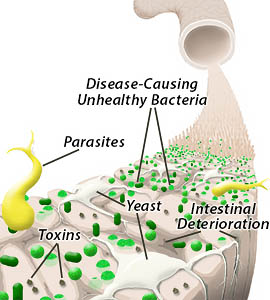
Unhealthy intestines can harbor toxins, parasites, harmful yeast species and overgrowth of disease-causing bacteria, including C. difficile.
The majority of Lactobacillus probiotics found in yogurts and supplements do not survive the hot, acidic stomach barrier.
Did you know the heating and pasteurizing process is performed after the growth of probiotics in yogurt? This kills most of the probiotics that were in the yogurt. On top of that, many common probiotic strains were taken from cows to ferment yogurt and cheese, and they are often not resident flora in the human gut. And dairy products are not well tolerated by most people with C. difficile.
Ultimately, yogurt and many common probiotic supplements are a poor choice and unlikely to provide any health benefits.
The Origins of True Probiotics
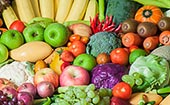
True probiotics are abundant in the soil and in nature.
But today most people have become separated from the land. Most foods are pasteurized, cooked or sterilized, effectively killing any probiotics they may have contained. Few people consume raw, unprocessed, naturally fermented probiotic foods. And people are constantly exposed to toxic environmental chemicals, stress and drugs that strain the microbiome and weaken the immune system.
Choosing the Best Probiotic for C. diff
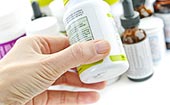 Spore-forming, true probiotics are my favorite choice, and they don’t have the limitations listed above. True probiotics can live both in oxygen or without it, making storage and shipping easy. True probiotics are part of every person’s unique microbiome and they survive the stomach at 100% potency3.
Spore-forming, true probiotics are my favorite choice, and they don’t have the limitations listed above. True probiotics can live both in oxygen or without it, making storage and shipping easy. True probiotics are part of every person’s unique microbiome and they survive the stomach at 100% potency3.
One of my favorites is the spore-forming Bacillus species, and they also combat C. difficile and other gut pathogens.

About the Author – Michelle Moore, BSc
Michelle Moore is a microbiologist, holistic health educator, and author of C. difficile Treatments & Remedies. With over 10 years of experience in pharmaceutical research and over 20 years in natural medicine, she helps people overcome C. difficile and other chronic infections naturally.
References
- Guidelines for the Evaluation of Probiotics in Food https://www.who.int/foodsafety/fs_management/en/probiotic_guidelines.pdf
- The Food Standards Agency conducted a study in conjunction with Reading University (Dr. G.R.Gibson, Dr. G. Rouzaud, Dr. J. Brostoff and Dr. N. Rayment) in the United Kingdom to evaluate the probiotic effect of commercial products in the human gut, and whether there was any impact on gut flora. The study evaluated the survivability of common probiotics through the gut, examining 35 strains from commercial products, primarily Lactobacillus sp. and Bifidobacterium sp.
- Commissioned gastric model study by Silliker Food Science Center – Crete, IL
Image credits: Bacteria combo graphic ©CDC and ©Les Moore, Human tree ©freshidea/Fotolia, Supplement bottles ©Elenathewise/Fotolia, children © raw foods ©Fotolia.com/peangdao, capsules ©Fotolia.com/Dmitry Lobanov, illustrations ©Lester Moore


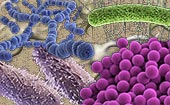

 Fill in the form below to get our C. diff. tips newsletter and your free report “10 Things You Need to Know to Overcome C. difficile”.
We value your Privacy. Your email will be kept strictly confidential & secured. See our
Fill in the form below to get our C. diff. tips newsletter and your free report “10 Things You Need to Know to Overcome C. difficile”.
We value your Privacy. Your email will be kept strictly confidential & secured. See our 